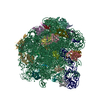+Search query
-Structure paper
| Title | A Structurally Characterized Evolutionary Escape Route from Treatment with the Antibiotic Linezolid. |
|---|---|
| Journal, issue, pages | Microbiol Spectr, Vol. 10, Issue 4, Page e0058322, Year 2022 |
| Publish date | Aug 31, 2022 |
 Authors Authors | Laura Perlaza-Jiménez / Kher-Shing Tan / Sarah J Piper / Rachel M Johnson / Rebecca S Bamert / Christopher J Stubenrauch / Alexander Wright / David Lupton / Trevor Lithgow / Matthew J Belousoff /  |
| PubMed Abstract | Methicillin-resistant Staphylococcus aureus (MRSA) is a bacterial pathogen that presents great health concerns. Treatment requires the use of last-line antibiotics, such as members of the ...Methicillin-resistant Staphylococcus aureus (MRSA) is a bacterial pathogen that presents great health concerns. Treatment requires the use of last-line antibiotics, such as members of the oxazolidinone family, of which linezolid is the first member to see regular use in the clinic. Here, we report a short time scale selection experiment in which strains of MRSA were subjected to linezolid treatment. Clonal isolates which had evolved a linezolid-resistant phenotype were characterized by whole-genome sequencing. Linezolid-resistant mutants were identified which had accumulated mutations in the ribosomal protein uL3. Multiple clones which had two mutations in uL3 exhibited resistance to linezolid, 2-fold higher than the clinical breakpoint. Ribosomes from this strain were isolated and subjected to single-particle cryo-electron microscopic analysis and compared to the ribosomes from the parent strain. We found that the mutations in uL3 lead to a rearrangement of a loop that makes contact with Helix 90, propagating a structural change over 15 Å away. This distal change swings nucleotide U2504 into the binding site of the antibiotic, causing linezolid resistance. Antibiotic resistance poses a critical problem to human health and decreases the utility of these lifesaving drugs. Of particular concern is the "superbug" methicillin-resistant Staphylococcus aureus (MRSA), for which treatment of infection requires the use of last-line antibiotics, including linezolid. In this paper, we characterize the atomic rearrangements which the ribosome, the target of linezolid, undergoes during its evolutionary journey toward becoming drug resistant. Using cryo-electron microscopy, we describe a particular molecular mechanism which MRSA uses to become resistant to linezolid. |
 External links External links |  Microbiol Spectr / Microbiol Spectr /  PubMed:35736238 / PubMed:35736238 /  PubMed Central PubMed Central |
| Methods | EM (single particle) |
| Resolution | 2.9 - 3.0 Å |
| Structure data | EMDB-26124, PDB-7ttu: EMDB-26125, PDB-7ttw: |
| Source |
|
 Keywords Keywords | RIBOSOME / 50S subunit / antibiotic resistance / linezolid |
 Movie
Movie Controller
Controller Structure viewers
Structure viewers About Yorodumi Papers
About Yorodumi Papers








